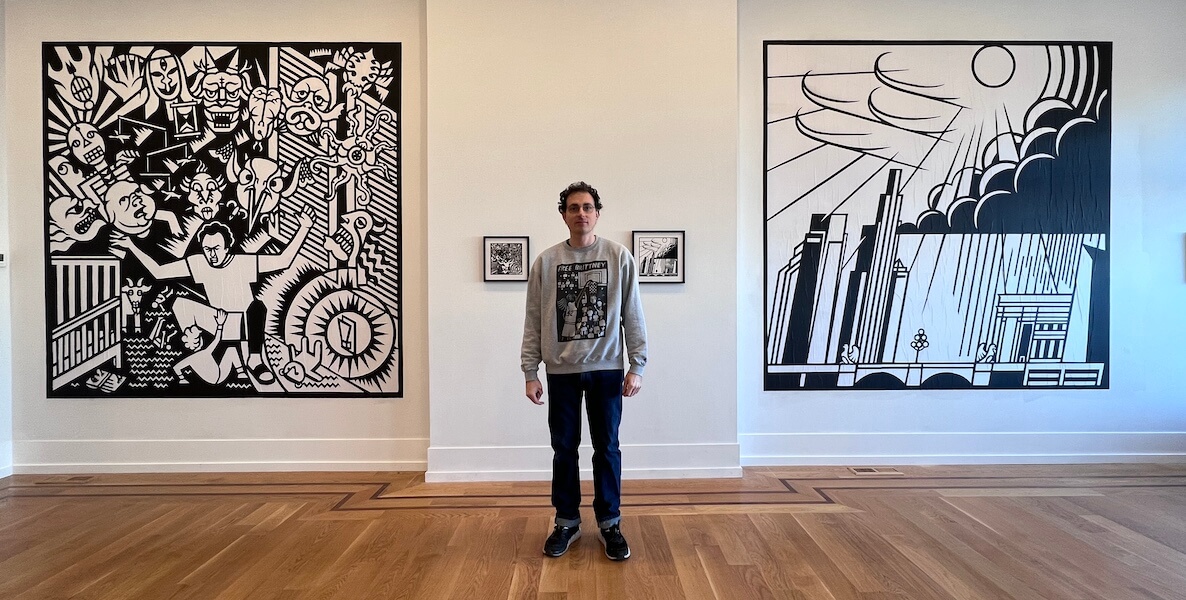Joe Boruchow is known for going big. He has made a name for himself with multi-story murals, immersive installations at the Philadelphia airport, and one design that spans the length of the 33rd Street Bridge in Brewerytown. So it’s easy to miss that Boruchow actually starts each piece quite small. For more than 20 years, Boruchow has specialized in paper cutouts. Everything begins with a sheet of black paper about the size of a vinyl record, and an X-ACTO knife, with which Boruchow meticulously slices away until an image emerges.
Philadelphia bleeds into Boruchow’s work — and vice versa. His pieces include nods to iconic buildings like the Comcast Center and the Philadelphia Museum of Art, along with references to ornamental iron fencing, intricate brickwork, and other often-overlooked architectural features. His marks on the city reside less in his murals (our city is full of them). And rather in street art that he designs to fit into particular architectural niches. For example, Boruchow sized a number of posters to fit perfectly into the arch of a USPS mailbox, where (despite being placed without permission) they immediately looked like they belonged. It’s that relationship, borrowing from the city while at the same time affecting it, that situates Boruchow as an artist ingrained into the fabric of Philadelphia.
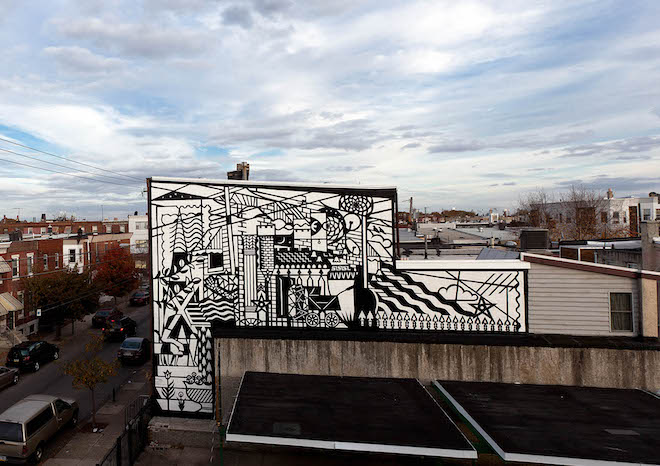
Monster Storm, a solo show from Boruchow at Space 1026, is an opportunity for fans to get a sense for his process and understand how an image that starts as cut paper can translate across much larger formats. Monster Storm includes 9-foot-tall posters glued to the wall, screenprints at a more collector-friendly scale, light boxes where Boruchow’s illustrations are backlit to emulate stained glass, and one-of-a-kind original cut paper pieces. Monster Storm is open by appointment through January 26. Contact Boruchow on Instagram to schedule a visit.
As part of a partnership with Forman Arts Initiative, the Citizen caught up with Boruchow. The interview has been condensed and edited for clarity.
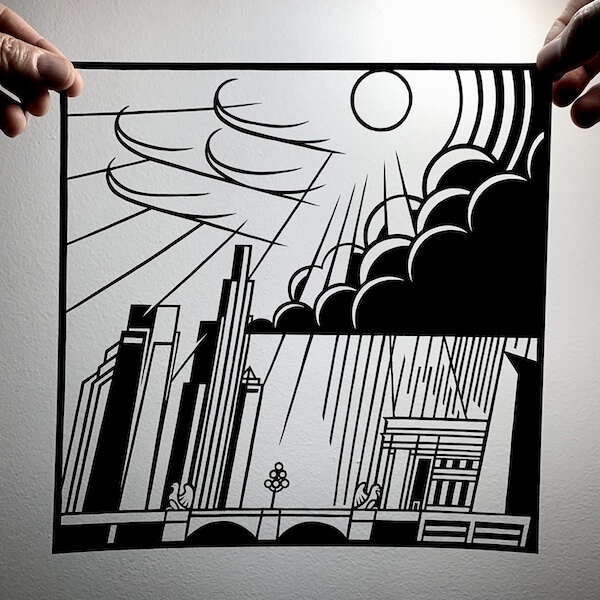
Rushmore: Your work is so intricate and delicate, yet also full of bold lines and shapes. That combination stems at least in part from your choice of medium. What are the challenges, and the opportunities, when working with cut paper?
Boruchow: One of the main challenges is getting all the paper to connect. There’s never any free floating black shapes, so things like facial features and belly buttons can be tough. But I’ve always felt most creative under constraints. I think that’s what keeps me interested in the medium of paper cutout. As for the graphic quality, I love how a piece is entirely made up of excised shapes. It’s so rudimentary in a way that I think it leaves a stamp on the viewer’s consciousness. It connects to a primitive way of seeing that is hard wired in all of us.
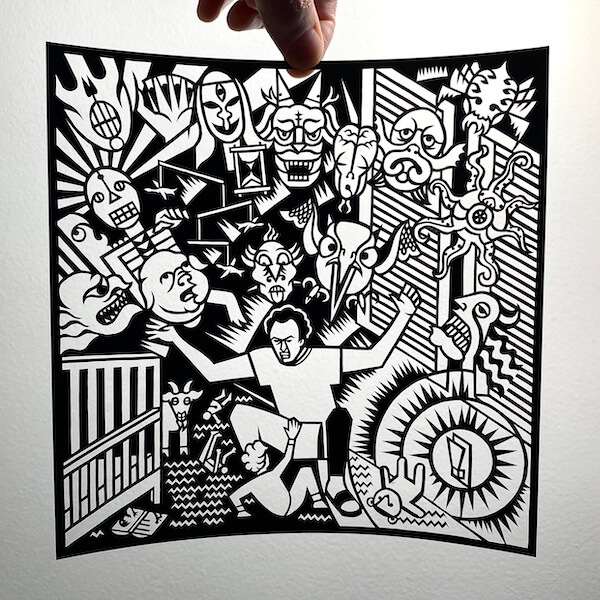
Another constraint you create for yourself is around shape. So many of your outdoor posters and murals are designed to fit like puzzle pieces into particular spaces where you’re both responding to and altering an existing space. How do you think about that push and pull?
I’ve always loved integrating my art into the landscape. It’s how I manage my relationship with my surroundings. Fitting in. Marking territory. And my hope is that my work provokes thought, emotion and, most importantly, adds beauty to the landscape.
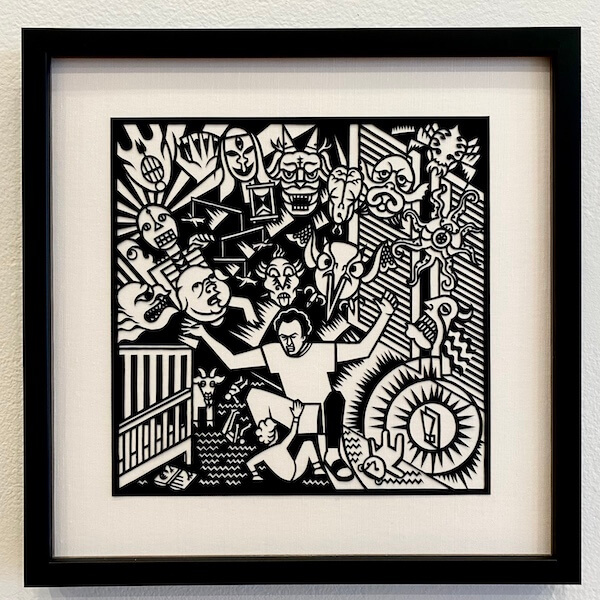
From criticizing the Union League for honoring Jeff Sessions to connecting the “Blue Lives Matter” to fascism, you don’t shy away from difficult subject matter. What responsibility do you feel that artists in general, or you personally, have to create visuals that explicitly engage with politics?
My political work is really just a way for me to work out my emotions on certain matters. I’m an emotional person and can sometimes feel overwhelmed by current events. It relieves a sense of powerlessness and frustration. I never think my work is changing anyone’s mind, but I hope it comforts other people who feel as I do.
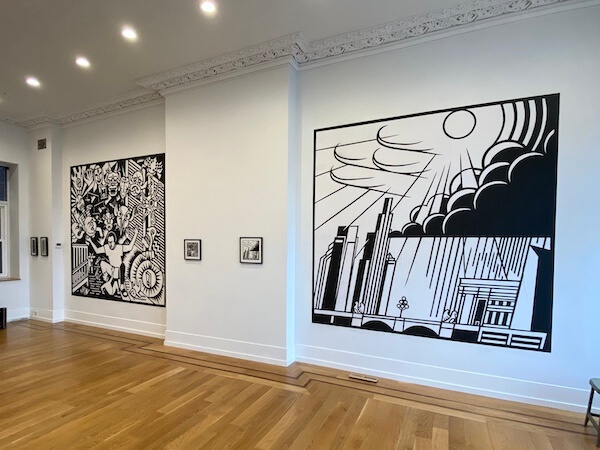
What’s behind the title of your current solo show at Space 1026, Monster Storm?
The two large installations in the show are called “Playing Monster at Bedtime” and “Storm Over Philadelphia.” Besides just liking the way Monster Storm sounds, I think it speaks to the work and some of its main themes like the tension between opposites in “Magnetic Field,” life and death in “Garden, and beauty and danger in “Lincoln Drive” and “Kelly Drive.” Each cutout is its own tempest.
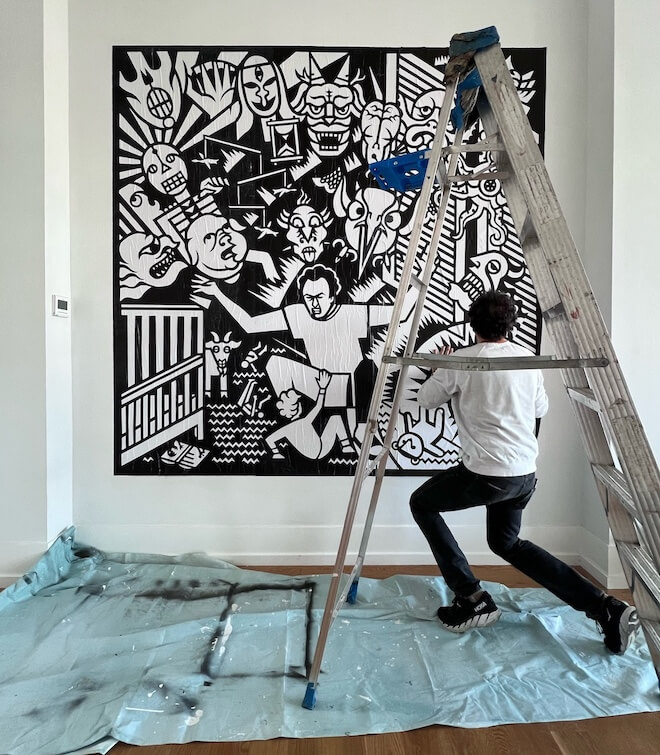
“Playing Monster at Bedtime” is an especially energetic piece. Can you talk me through it? What’s the story, and where did this imagery come from?
“Playing monster at bedtime” is a game I used to play with my son. With this piece, I was also thinking about how parents pass their demons down to their children. It’s a reminder to be conscious of this phenomenon and to sublimate it when possible. The Japanese printmaker Kuniyoshi and the Belgian painter James Ensor inspired many of the monsters in this cutout.
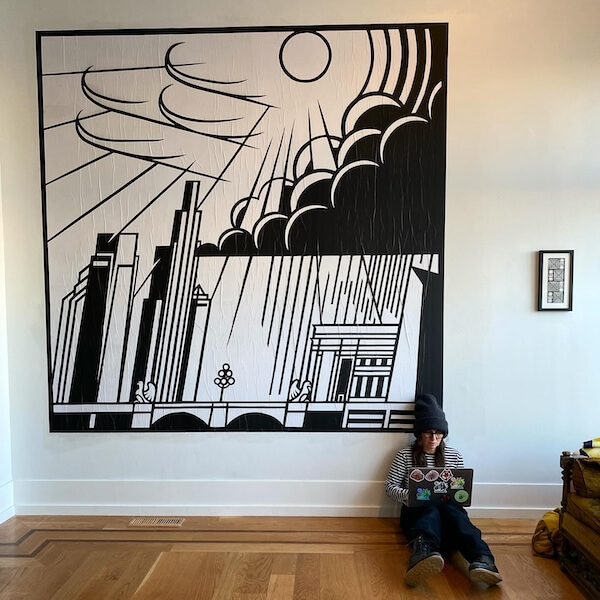
With both “Playing Monster at Bedtime” and “Storm Over Philadelphia,” this show gives fans a chance to see two sides of your work and better understand your process. Both images are exhibited twice, once in the form of the original cut paper and once as oversized posters glued to the wall. How do you convert an image from a delicate 9 x 9 inch papercut to a bold 9 x 9 foot poster? What led you to install both formats in this show?
To enlarge an image, I photograph the cutout on a light box and then blow it up in Adobe Illustrator. It is then printed in 3’ x 9’ panels and assembled on the wall. I’m really excited to show the original cutouts next to these large-scale paste ups because it gives the viewer a chance to see the contrast between the intricate original and the large-scale install that they might come across if they see my work on the street. I remember seeing Dali’s melting clock painting for the first time and marveling at how intimate it was compared to the enlarged photos of it I had seen in books and posters. My aim is to give people that same sense when they see these two versions together.
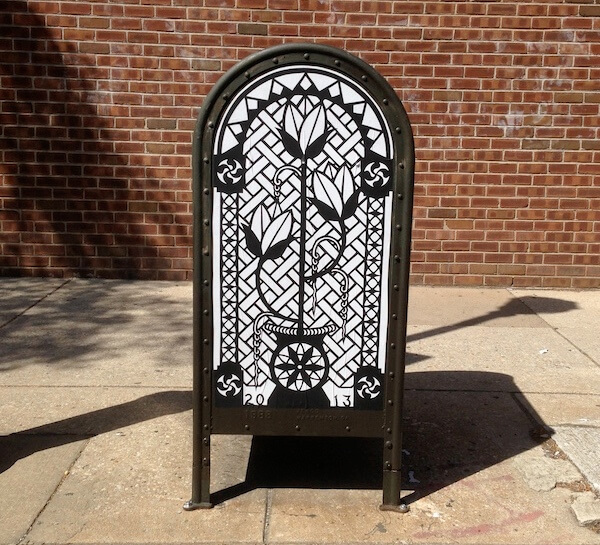
Monster Storm also features a new medium for you, with a series of light boxes that see your papercuts translated to vinyl and set in beautiful wooden frames. How did those come about?
I’ve done some very rudimentary light boxes before, but I always wanted to make some finely finished larger ones. When working with [photographer] Jessica Kourkounis, who curated the show, I mentioned this and she informed me that, between her carpentry skills and Space 1026’s artisan connections, we could make that happen! I’m really pleased with how they turned out.
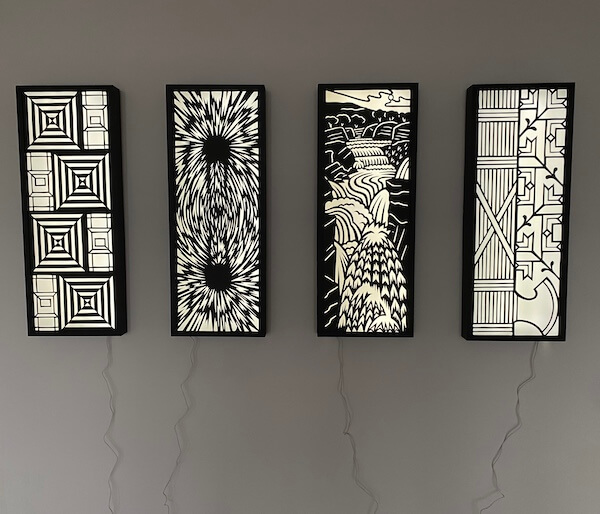
In your work, I’ve spotted the Schuylkill, lots of iconic architecture, and even references to local graffiti. What is it about Philadelphia that you keep coming back to?
Philadelphia is my home. I’ve lived here for 27 years and I’m raising my family here. I can’t help but make it the setting for the story in many of my cutouts. Also, my father was from New York City and I grew up surrounded by art that he collected by John Sloan, William Glackens, and other Ashcan School artists who portrayed scenes of daily life there. I’m sure that had an effect on how I use my home city in my own work.
RJ Rushmore is a writer, curator and public art advocate. He is the founder of the street art blog Vandalog and culture-jamming campaign Art in Ad Places. As a curator, he has collaborated with Poster House, Mural Arts Philadelphia, The L.I.S.A. Project NYC and Haverford College. Rushmore’s writing has appeared in Hyperallergic, Juxtapoz, Complex and numerous books. He holds a B.A. in Political Science from Haverford College, where his thesis investigated controversies in public art.
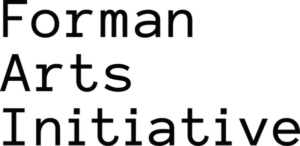
This story is part of a partnership between The Philadelphia Citizen and Forman Arts Initiative to highlight creatives in every neighborhood in Philadelphia. It will run on both The Citizen and FAI’s websites.
![]() MORE FROM OUR ART FOR CHANGE SERIES
MORE FROM OUR ART FOR CHANGE SERIES



